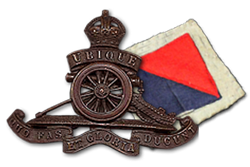27th Anti-Aircraft Brigade was an Air Defence formation of the British Army in World War II that served in The Blitz and later converted to infantry.
The 28th (Essex) Searchlight Regiment was a volunteer air defence unit of Britain's Territorial Army (TA) from 1935 until 1961, at first as part of the Royal Engineers, later in the Royal Artillery. During World War II it defended the approaches to London in The Blitz and Operation Diver before becoming a garrison unit in the liberation of Norway.
The 29th (Kent) Searchlight Regiment was a volunteer air defence unit of Britain's Territorial Army (TA) from 1935 until 1955, at first as part of the Royal Engineers (RE), later in the Royal Artillery (RA). It served during The Blitz, defended South West England and the Orkneys and Shetlands before becoming garrison troops in North West Europe.
30th (Surrey) Searchlight Regiment was an air defence unit of Britain's Territorial Army from 1924 until 1961. During World War II it served in The Blitz and later in the Tunisian and Italian Campaigns, while detachments from the regiment served in the Far East and were captured at the Fall of Singapore.
The 30th (Northumbrian) Anti-Aircraft Brigade was an air defence formation of Britain's Territorial Army from 1936 until 1955, which defended Tyneside and Sunderland during World War II.
The 31st Anti-Aircraft Brigade was an air defence formation of Britain's Territorial Army from 1936 until 1948. During World War II it defended West Yorkshire and later participated in the North West Europe campaign.

The 79th Heavy Anti-Aircraft Regiment, Royal Artillery was an air defence unit of Britain's Territorial Army (TA). Formed just before World War II, it fought in the Battle of France, the Swansea Blitz, Operation Torch and the Italian Campaign. It continued serving in the post-war TA until 1955.
The 32nd (Midland) Anti-Aircraft Brigade was an air defence formation of Anti-Aircraft Command in Britain's Territorial Army (TA) from 1936 to 1955, charged with defending the East Midlands of England.
35th Anti-Aircraft Brigade was an air defence formation of Anti-Aircraft Command in the British Territorial Army (TA) formed shortly before the outbreak of World War II. It defended the important naval base of Portsmouth during The Blitz.

The 51st (Highland) Searchlight Regiment, Royal Artillery was a Scottish unit of Britain's Territorial Army (TA) formed for air defence just before World War II. It later served as an anti-aircraft (AA) artillery unit in the North West Europe Campaign 1944–45, and continued in the postwar TA into the 1950s.

The 59th (Warwickshire) Searchlight Regiment, Royal Artillery was an air defence unit of the Territorial Army (TA), part of the British Army, and was raised in Birmingham in 1938 just before the Second World War. It later served as a light anti-aircraft gun unit and continued in the postwar TA.
The 73rd Searchlight Regiment was a volunteer air defence unit of Britain's Territorial Army (TA) from 1939 until 1955, at first as part of the Royal Engineers, later in the Royal Artillery. It served during the Battle of Britain and The Blitz.
The 37th Anti-Aircraft Brigade was an air defence formation of Britain's Territorial Army (TA) formed just before the outbreak of World War II. It was engaged in defending the Thames Estuary during the war, and continued to form part of Anti-Aircraft Command in the postwar era.

The 133rd Light Anti-Aircraft Regiment, was an air defence unit of Britain's Royal Artillery during World War II. It saw action during the campaign in North West Europe, defending the vital port of Antwerp against V-1 flying bombs and supporting the advance into Germany.

The 76th Searchlight Regiment, Royal Artillery was a British Army air defence unit during World War II. It was engaged during the Battle of Britain and The Blitz, defending Royal Air Force airfields and the towns of southern England.
50th Light Anti-Aircraft Brigade was an air defence formation of Britain's Territorial Army (TA) during World War II. It defended the North Midlands of England during The Blitz and later helped to protect Brussels from V-1 flying bombs during the Campaign in North West Europe.

85th (Tees) Heavy Anti-Aircraft Regiment, Royal Artillery was a part-time unit of Britain's Territorial Army (TA) formed on Teesside just before the outbreak of World War II. Its service during the war included the Battle of France and Dunkirk evacuation, the Battle of Britain and Blitz, and the North African and Italian campaigns. It continued to serve in the air defence role until 1961.
3rd Anti-Aircraft Brigade was a Supplementary Reserve air defence formation of the British Army formed in Northern Ireland in 1938. On the outbreak of World War II it saw active service with the British Expeditionary Force during the Battle of France and Operation Aerial. It then returned to Northern Ireland and defended the Province for the next two years. Postwar, it was reformed in the Territorial Army and served until the disbandment of Anti-Aircraft Command in 1955.
The 5th Anti-Aircraft Brigade was an air defence formation of the British Army during World War II. It was formed as a searchlight brigade to protect the British Expeditionary Force's bases just before the Battle of France. After the Dunkirk evacuation it was reformed as a conventional anti-aircraft (AA) brigade and served through the rest of the war in Anti-Aircraft Command, defending various parts of the United Kingdom against bombing raids and V-1 flying bombs. It continued to serve in the Regular Army during the early postwar years.
45th Anti-Aircraft Brigade was an air defence formation of Britain's Territorial Army (TA). Formed in 1938, it was responsible for protecting South Wales during World War II. It was reformed in the postwar TA under a new title, and continued until 1955.







